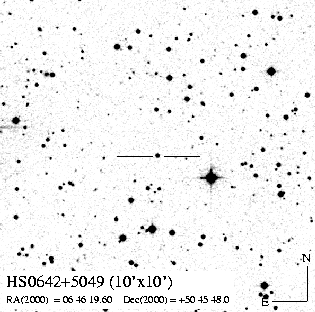There is a group of three objects of this kind, HS0139+0559, and HS0229+8016, and HS0642+5049. Finding out their true nature would be a nice project.

|
Here we have a rather odd CV: its spectrum looks like a novalike
should look like, with an optically thick hot disk, i.e. Balmer
absorption lines, superimposed by some weak Balmer emission. Despite
intense spectroscopic observations, we could not detect any radial
velocity variation in the Hα line, though. The object does,
however, show a decent photometric modulation with an amplitude of
0.2-0.4 mag and
period of 225.9min, which we believe to be the orbital
period. Monitoring is necessary to tell whether this is indeed a
novalike, which is always bright (and, possibly does show some deep low
states, as the VY Scl stars), or if it is a Z Cam dwarf nova which we
just happened to observe always in outburst or standstill.
There is a group of three objects of this kind, HS0139+0559, and HS0229+8016, and HS0642+5049. Finding out their true nature would be a nice project. |
 |